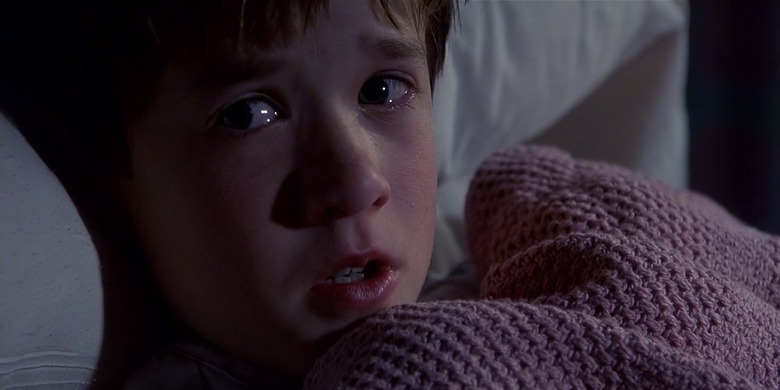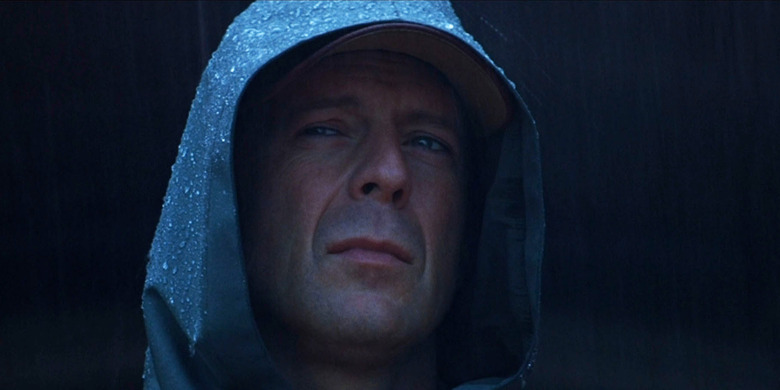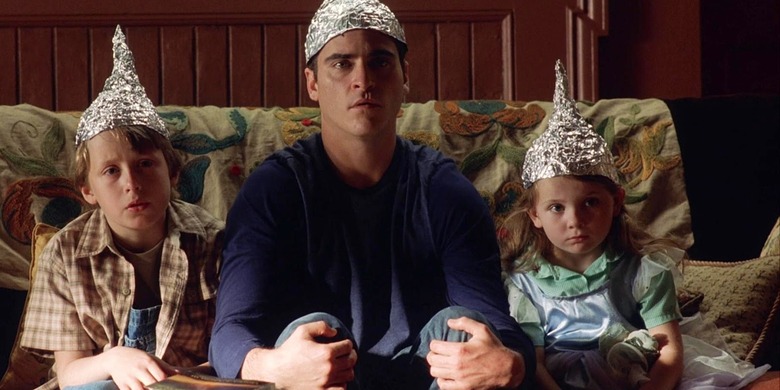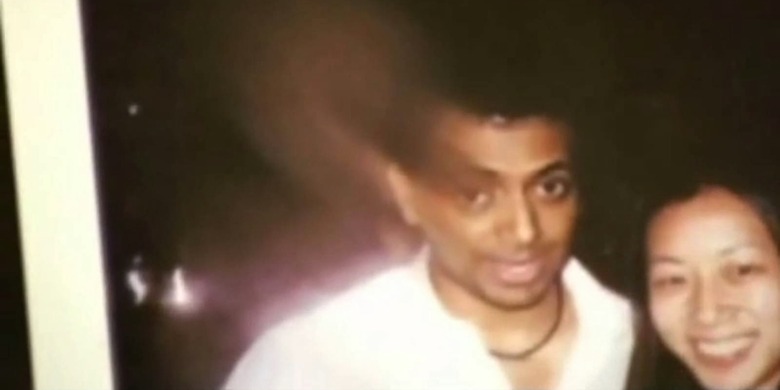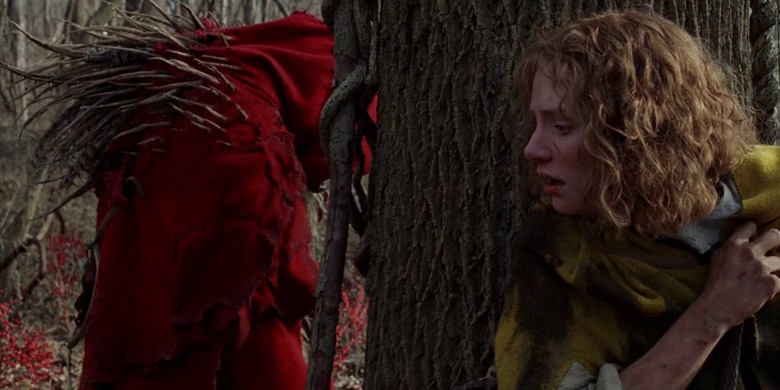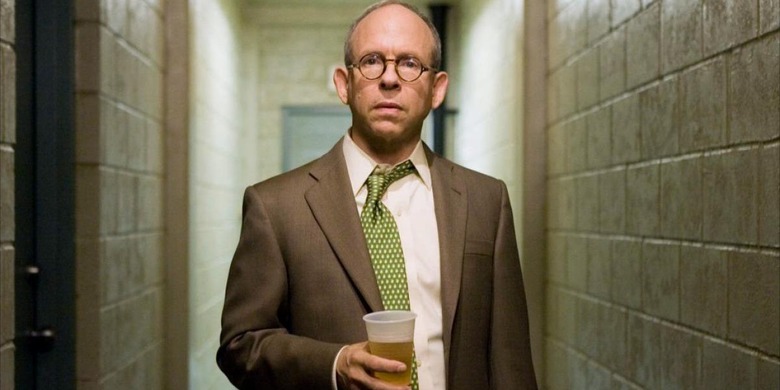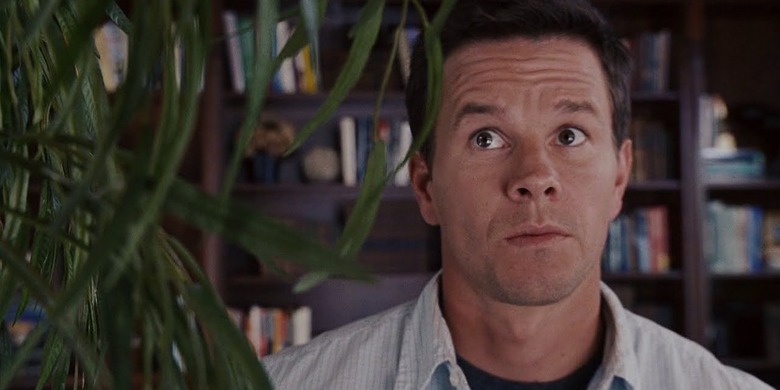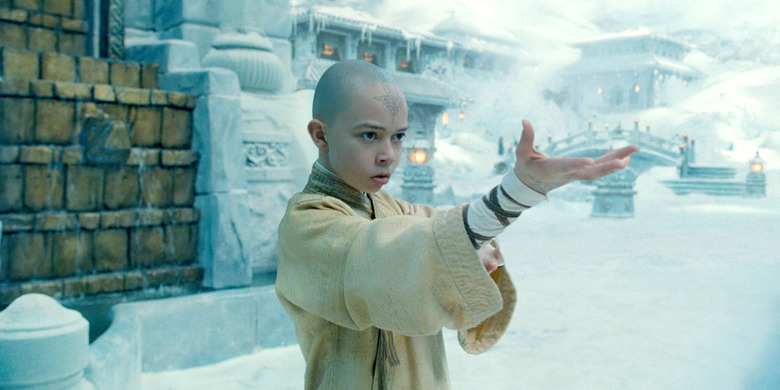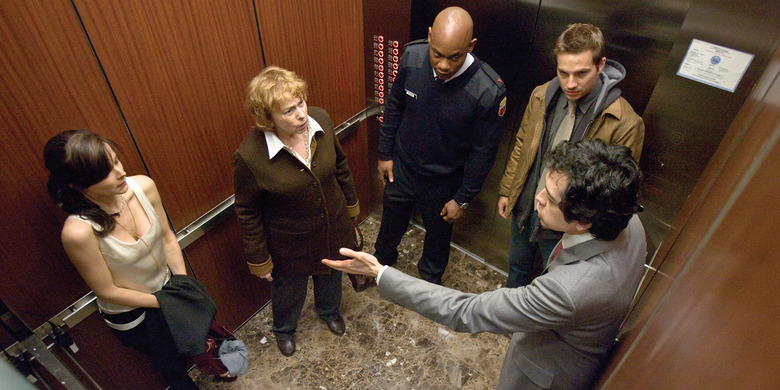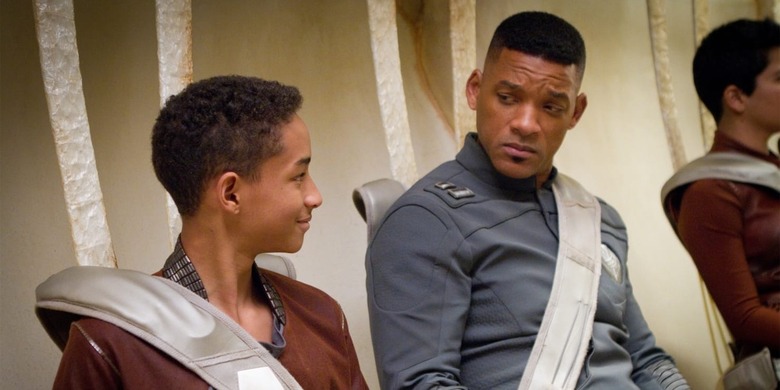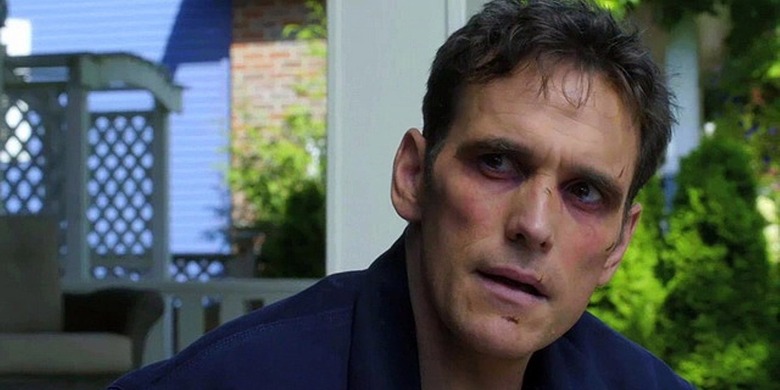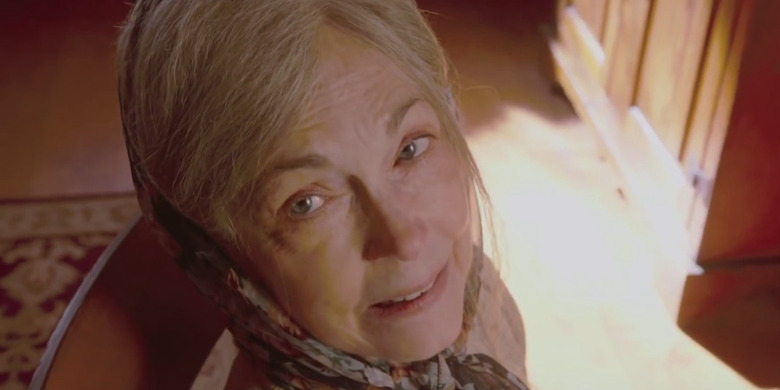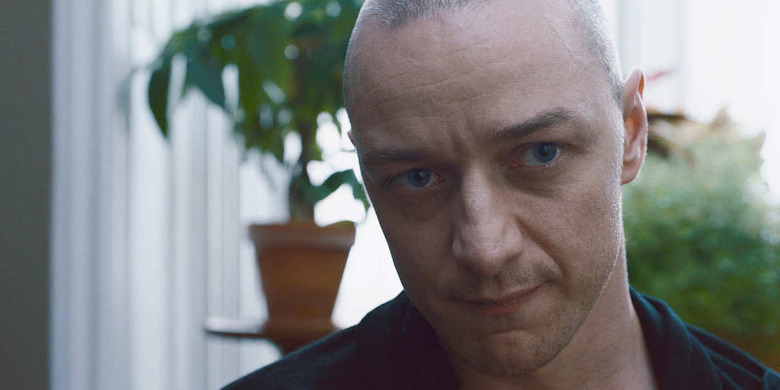The Films Of M. Night Shyamalan Revisited: The Twists, The Triumphs, And The Turkeys
Early reviews of Glass, the first big movie of 2019, have mentioned how writer-director M. Night Shyamalan was once seen as the next Alfred Hitchcock or Steven Spielberg. For at least a three-year stretch at the turn of the millennium (five, if you count the two years after Signs, but before The Village), Shyamalan stood as a worthy successor to the throne of populist filmmaking, capable of delivering high-concept thrills in an intimate, character-based way. Maybe the world at large needs reminding of his erstwhile crowd-pleaser status, because it's been a long time since he graced the cover of Newsweek magazine. Among cool kids, there's a rather revisionist tendency now to discount the years of widespread appeal Shyamalan enjoyed before he became a critical punching bag and a laughingstock among audiences during movie trailers.
More than any other living filmmaker, perhaps, Shyamalan is one who has experienced the extreme highs and lows of mass popularity. Some rate him a cinematic one-hit wonder. If you were basing that solely on the global name recognition of The Sixth Sense, you might be right. Others reckon him a two-hit wonder, with everything after Unbreakable being a mixed bag ... but if you'll forgive the subliminal Signs pun, that doesn't quite hold water, either. To really come away with a full appreciation for the arc of Shyamalan's career and how it went wrong, then right again, you'd need to take a deep dive into his filmography. 1999 was the year he broke through to the cultural mainstream; the first sign of trouble came half a decade later, with a TV movie called The Buried Secret of M. Night Shyamalan.
Twenty years. Twelve movies. One "event series" on television. Let's board the quality roller coaster and take a long ride through Shyamalan history.
It's important to note up front that this isn't a ranking of Shyamalan's films. Nor is it a list examining every single project he's ever been involved in as a writer, director, producer, and actor (sorry, Stuart Little fans). Rather, this is a chronological analysis of his main filmography: his directorial work since 1999, along with a few other projects where the Shyamalan "brand" can be regarded as an essential part of the creative force.
In each section, spoilers are fair game for the title being discussed, so if you haven't watched something, skip to the next section as we make our way toward the finish line of Split, the movie that sealed Shyamalan's comeback and brought us to where we are now, nervously awaiting the release of Glass. Along the way, specific patterns will begin to emerge: Shyamalan's films often have a psychological component to them (it can't be a coincidence that he married a psychologist), and throughout his body of work, there's an overwhelming preference for contained settings. There's also a recurring interplay between belief and doubt, whether it be belief in the supernatural or extraordinary, or even just belief in oneself.
If you missed the Shyamalanathon at the Alamo Drafthouse, there's no better time than the movie wasteland of January to start staging your own Shyamalanathon at home. Without further ado, let's trek back through the peaks and valleys of M. Night Shyamalan's career.
THE SIXTH SENSE (1999)
Nominated for six Academy Awards, including Best Picture, Best Director, and Best Original Screenplay, Shyamalan's breakthrough hit is the benchmark by which all his subsequent films have been judged. The Sixth Sense is not his first movie, but it might as well be, given the relative obscurity of his two previous features. As '90s twist endings go, I always preferred the one in The Usual Suspects, but several years ago, The Sixth Sense actually beat it and topped a poll of the greatest movie twists of all time. It also contains one of the great movie quotes of all time, which has been repeated and parodied ad nauseam ever since the movie's release.
That line, "I see dead people," is delivered by a little boy named Cole Sear with the bedcovers tucked up under his chin. He's speaking to a child psychologist, Malcolm Crowe, who doesn't realize the significance when Cole further explains, "They only see what they want to see. They don't know they're dead."
Even if people don't remember the character names, they're sure to remember the precocious child actor, Haley Joel Osment, as well as the head-spinning twist that Bruce Willis's character was dead all along. If you go back and watch The Sixth Sense now, it seems painfully obvious that Malcolm is dead. 21st-century viewers have been trained to spot clues and develop Reddit theories; if the movie were released circa 2019, people would probably figure out the twist and be live-tweeting it before the credits rolled.
It's not just a few random clues that are sprinkled throughout The Sixth Sense. With his wife and Cole's mother, Malcolm moves through a parade of non-interactions—not to mention the whole subplot where he's watching a young gentleman caller pursue his wife right under his nose. The movie constantly telegraphs the twist for us so that when it finally lands, it feels organic, in line with everything we've seen before. That's what makes it such a good twist: because it's been hiding in plain sight all along. It doesn't try to alter the foundation of the movie so much as re-contextualize the buildup of previous scenes using available information. The problem, perhaps, with later Shyamalan films like The Village is that they would try to outsmart the audience, withholding information and springing a late twist that didn't jibe with what the audience knew (or thought it had been sold).
There's more to The Sixth Sense than its twist ending, of course. James Newton Howard's score is wonderfully moody, and the idea that ghosts just want to make peace is something that has informed the twists of other horror movies like The Ring. Rewatching Toni Collete play a mother caught in the middle of a supernatural situation she doesn't understand, it's hard not to think of her awards-worthy performance in Hereditary last year, either. As a sacrificial lamb, her character in that movie stood purposely uninformed, but general audiences reacted negatively to that on opening weekend.
There's a theory that the twists in Shyamalan's films only work if the audience learns them the same time the main character does. Whether or not that's true, the twist in The Sixth Sense is one that flows naturally. For better or worse, he's been chasing the wonder of that moment ever since.
UNBREAKABLE (2000)
Compared to The Sixth Sense, Unbreakable is more of a cult classic. It seems strange to think of a movie that way when it grossed a quarter of a billion dollars worldwide, but that was almost two decades ago and it was only after Unbreakable underperformed at the domestic office. Today, if you started accosting random strangers on the street — or even casual filmgoers outside the evening multiplex — you might not find as many people who could solve the Unbreakable hint on your movie crossword puzzle.
On the other hand, if you got a bunch of hardcore cinephiles together in a room, Unbreakable would surely garner the most votes for "best Shyamalan film." It's a movie that's grown in stature since its initial release, so much so that it's easy to forget it holds a 69% Tomatometer score (which puts it in good company, considering that the retroactive score for Tim Burton's Batman only crept up over 70% a few years ago).
I first saw Unbreakable at a theater in Manhattan on Thanksgiving Day 2000. It was right after watching the Macy's parade file through Times Square, where I often visited the Midtown Comics shop. I remember my toes were freezing from standing out in the cold that morning ... and then I sat down to watch this chilly drama about a real-life superhero named David Dunn. True to form for an M. Night Shyamalan movie, there was a twist at the end, one that felt mildly clever and appropriate to the dynamic established between Dunn and his weak-boned character foil, Elijah Price.
For a 19-year-old, the movie wasn't an instant classic. Chalk it up to Unbreakable's muted color palette, which only comes alive at odd moments, like the one where we're looking straight down from the ceiling at a carpet with yellow circles and purple and green squares (three important colors, as it turns out, in the Shyamalan shared universe). Otherwise, the look of the movie is perhaps intentionally drab, to reflect the inner life of its main character. Shyamalan recently tweeted about this vis-a-vis Glass, saying: "As the characters believe in the comic book world the primary colors in the film become more dominate [sic]. As they stop believing they fade to a monochromatic world."
The Dunn of Unbreakable has spent much of his adult life trapped in that monochromatic world. Once a promising athlete, he sacrificed his football career to be with the woman he loved, but now their marriage is crumbling and he finds himself undergoing a mid-life crisis of sorts. Maybe that's why Unbreakable's reputation has improved with age: because its audience needed to grow up before it could fathom the melancholy of a middle-aged security guard.
Whatever the case, this is the soul of Shyamalan's filmography. It's a story about a man awakening to his true potential, and another man who believes so strongly in that potential that he's willing to perpetrate crimes to prove his own ideas. Dunn is the hero in hibernation; Price is the villain whose self-assured intellect belies a basic fragility. In a way, maybe these two characters can be seen as different aspects of Shyamalan's artistic personality, which would only grow more fractured (or split) as the years wore on.
SIGNS (2002)
Never mind the water. It's a weakness for David Dunn and it's a weakness for this film (even more than it's a weakness for the film's extraterrestrials). Signs thrives on its spooky atmosphere and the strength of its performances. Cornfields at night are inherently creepy ... throw in the unexplained phenomena of crop circles, and you've got the makings of a suspenseful alien invasion thriller, told on the smaller scale of a single remote farm.
For a long time, Signs was my personal favorite Shyamalan movie—until I rediscovered Unbreakable as an adult and Split came along and blindsided me. I could go on all day about Signs, but to keep the discussion here (and this already lengthy dissertation on Shymalan) manageable, let's limit the focus to two key scenes in the film.
One is the Brazilian birthday party scene. Merrill Hess, played by Joaquin Phoenix, is in the closet with a TV. He's asleep, but a news report comes on TV showing home video footage from a 7-year-old's party. Observe Merrill's body language: he sits up, takes notice, pulls in his chair, and leans in so close that we see the light of the TV on his face. He's literally on the edge of his seat, and so are we now.
Shyamalan draws out the tension, letting it mount until the moment when we see a gangly alien come sauntering out from behind the bushes in the video. Whether or not you believe the special effects in that moment, Phoenix's wide-eyed gasp and recoil sell how real the alien is. It's a well-staged moment in a film that's still eminently watchable.
The second scene is the one where Merrill and his father, Graham, an ex-minister who has lost his faith, are talking on the couch at night. In this scene, the TV is also playing, with the news showing mysterious lights in the sky. Mel Gibson plays Graham. This was his most commercially successful film as an actor. At the time, he was still a marquee-friendly name, but Signs would be his last film as a movie star before he pivoted to directing and his career was tainted by a series of ugly controversies.
Whatever you think of Gibson circa 2019, the couch scene is still one of the more memorable dramatic scenes he ever acted in outside of Braveheart. It's a quiet moment where Signs lays out the meaning of its title. Offering comfort to his son, Graham talks about how people break down into two categories: those who believe in miracles and see signs everywhere, and those who believe no one's watching over us and we're alone in a world full of coincidences.
The knife-twist comes when Graham reveals that he now belongs to the second category, ever since he watched his wife die. He paints a vivid picture of her final moments—how the nerve endings in her brain were firing, filling her head with seemingly random, or perhaps not-so-random, baseball memories. Cue alien shadow on a black TV monitor. "Swing away, Merrill."
THE BURIED SECRET OF M. NIGHT SHYAMALAN (2004)
An important precursor to Shyamalan's next film, The Village, is the marketing stunt gone awry that was The Buried Secret of M. Night Shyamalan. This TV movie was a pseudo-documentary that aired on the Sci-Fi Channel just before The Village went into theatrical release. Billing it as an expose, one that Shyamalan did not approve of, Sci-Fi tried to pass it off as a real documentary with the Associated Press. However, the stunt backfired when it was revealed to be a hoax—engineered partly by Shyamalan himself.
Counting commercials, The Buried Secret of M. Night Shyamalan was a three-hour affair. Today, if you watch it on YouTube with a sense of humor, parts of it play like a mockumentary ... but there's an unmistakable undercurrent of narcissism that runs through the whole thing. Shyamalan's theatrics never seemed more self-serving than they do here.
The story broadly involves a documentarian, Nathaniel Kahn, who is given unprecedented access to Shyamalan, only to find himself increasingly stonewalled as he grows closer to unearthing the filmmaker's titular "buried secret." Writing for IFC.com, Matt Singer called it "a three-hour film about a guy waiting to meet [Shyamalan]."
When Kahn first encounters Shyamalan's protective publicist, she gives him a list of pre-approved questions and lays down ground rules like, "Don't make eye contact with Night while he's directing." Going off-script, Kahn begins conducting unauthorized interviews with various Philadelphia locals (and even some random celebrities like Deepak Chopra and Johnny Depp), whereupon he discovers that Shyamalan drowned in a pond and was dead for thirty-five minutes when he was young. Hence the hydrophobia of Unbreakable and Signs.
As if that weren't enough, the documentary would also have you believe that Shyamalan has had a legit connection to the supernatural ever since his near-death experience put him in touch with "the other side." He literally "sees dead people." (One of them is a boy named Henry who drowned in the same pond.) This is why his very presence seems to attract a murder of crows, setting off audio malfunctions and other technical difficulties.
As he traipses through the woods on the set of The Village, the camera zooms in on Shyamalan like Bigfoot. Fans wait outside his home, hoping to make a Shyamalan sighting. They talk about him in chat rooms and accost him for pictures in pool halls, where the beneficent Shyamalan goes down among the people, like Jesus himself. Interview subjects refer to him as an "old soul" and equate him to "a shaman for modern society." Yet one anthropologist warns us, "If circumstances are problematic, that very person that is revered and seen as a healer or visionary can come under attack."
As it turns out, these words would be ultra-prophetic for Shyamalan's own film career.
THE VILLAGE (2004)
The Village engenders mixed feelings. It's the first Shyamalan film where I left the theater disappointed, but in hindsight, I can appreciate what he was trying to do, thematically. The crux of my disappointment — and that of other filmgoers, I imagine — lay in how the movie undercuts its own magic with one of its twists. This is something that /Film's Chris Evangelista picked up on his Unpopular Opinion defense of the movie. As he put it:
"Up until The Village, the twists in Shyamalan's films were in service of supernatural elements. They confirmed that there was some sort of otherworldly force working within the universe – something beyond our comprehension. The Village is the inverse of this, a film that blatantly says the supernatural is, in fact, a farce – that everything we thought we could believe in was a lie."
Trailers peddled The Village as a monster movie, teasing our imagination with the idea of a gothic New England tale where creatures in the woods stalked the perimeter of a 19th-century community. With cinematography by Roger Deakins, the film's striking imagery showed us figures in yellow hoods and a perimeter ringed with watchtowers, where oil lanterns burned in the night.
However, like a certain long-bearded terrorist leader in a well-known comic book sequel, it turned out that the film's monsters, the dreaded "Those We Don't Speak Of," were merely a costumed fear-mongering tool. While this might make for an interesting allegorical statement — especially when your movie about grief and isolationism is released into the immediate post-9/11 world like The Village was — it doesn't necessarily make for the most satisfying dramatic payoff to the mystery-box fantasies drummed up by the film and its marketing.
As for the movie's other twists, The Village is the film that introduced Bryce Dallas Howard to the world, and I was fine with the bait-and-switch of having her character emerge as the true protagonist after Joaquin Phoenix's character was unexpectedly sidelined. More assailable is the twist whereby we learn that the supposed 19th-century village exists on a protected wildlife preserve in modern-day America. What really killed that revelation for me is how Shyamalan, in this instance, uses his obligatory cameo to explain how "government guys had been paid off to keep plane routes from flying over this place."
He's unloading a whole stream of expository dialogue as he says this, and the park ranger he's talking to shows himself to be fidgety and uncomfortable. The ranger's eager to get the medicine he needs in the office and then leave, but Shyamalan keeps talking; he's inserted himself in his own movie to explain everything for the viewer. It's a clumsy bit of apologism that smacks of insecurity and hubris on the part of the filmmaker, and as Shyamalan's next movie showed, it wouldn't be the last time we saw him write and act himself into a defensive corner.
LADY IN THE WATER (2006)
Narfs and Scrunts? I smell bullshit. Lady in the Water was perhaps the first unfiltered whiff of it in Shyamalan's feature filmography. This is a movie in need of some serious tough love. It's the film that caused Shyamalan to divorce himself from his longtime studio partner, Disney, when executives there like Nina Jacobson failed to give him "a truthful reading" of the script. Or was it just that their misgivings were very much truthful and he refused to accept the deficiencies of his own material? Either way, Shyamalan's airing of grievances in a tell-all book broke the Hollywood code of silence and can perhaps be seen as the impetus for a major downward turn in his career. He would never be the same after Lady in the Water.
The plot of the movie revolves around a water nymph who lives in the swimming pool at an apartment complex. Even as a nominal "bedtime story," it craps the cot. I won't try to rehash the overcooked mythology because it's pure gobbledygook, full of many pretentious capitalizations. All you need to know is: Narfs and Scrunts. Let that phrase roll over your tongue and see if it doesn't taste make-believe.
A lot of people probably never saw The Buried Secret of M. Night Shyamalan, and those that did could maybe forgive it as a Star Wars Holiday Special-like curio that had no bearing on the big screen. Dutiful DVD buyers like yours truly were even willing to giving The Village a second chance, overlooking its muddled execution in favor of it as a fear allegory (one with a great deal more artistry to it than After Earth would later prove capable of mustering).
Lady in the Water is the precise dot on the timeline where fans like me started to fall away from Shyamalan in droves. It's there in the box office numbers: this remains his lowest grossing film since The Sixth Sense. Critics took against it for obvious reasons: there's a character in this movie, one Harry Farber, played by Bob Balaban, who is a know-it-all film critic. His bad advice and outright pedantry ultimately get him killed by a grass wolf. Score one for the scrunt.
That's actually the most interesting aspect of the movie: how it functions as a knowing discourse from Shyamalan to his critics. Whether or not they'd be willing to admit bias because of it, Farber could only be regarded as a personal effrontery to movie reviewers of the day. While I doubt he meant to willfully antagonize anyone, Shyamalan was — in a playful, or perhaps petulant, move — flubbing his nose at them, while biting the studio hand that fed him, to boot. If there was a grudge there, he was fanning the flames of it while displaying ignorance of his own shortcomings.
Other films, like Brad Bird's Ratatouille, have memorably toyed with the figure of the critic, showing us a cartoon effigy of intellectual pride with the fitting name of Anton Ego. The problem with Lady in the Water is that it also showed us Shyamalan himself playing a kind of divinely inspired Author whose next monumental book will inspire presidents and change the world.
At this point, the writer-director had lost all restraint with his cameos, as if he didn't have enough objectivity to recognize that there was a significant conflict of interest between telling a good story and giving himself a plum role that would massage his own ego. As self-aware as the fatal hallway encounter with that grass wolf is — with the critic blinking stupidly at the camera — Shyamalan was unable to reign in his own wayward self-indulgence in Lady in the Water.
THE HAPPENING (2008)
Why you eyeing my lemon drink? I almost wish we could leave it at that. Grim as its procession of R-rated suicides is, people love to talk about how The Happening is unintentionally funny. Shyamalan was always somewhat corny but this is campy in a way that's downright nebulous.
It's not always clear whether the movie means to be taken seriously. Maybe it does sometimes, and that's the problem. If we can run with the idea that Shyamalan is a filmmaker with multiple personality disorder — like James McAvoy's character in Split — then The Happening is a film where he appears to have been torn between clashing impulses. It's essentially a 90-minute struggle between his sensibilities as a serious dramatist and his aspirations as a tongue-in-cheek parodist.
This struggle keeps the viewer off-balance to where you never are sure how intentional the biting hilarity of Mark Wahlberg's performance as a science teacher is. Was Wahlberg in on the joke, or was Shyamalan coaxing some of the old Dirk Diggler out of him, putting him in embarrassing poses like a borrowed Ken doll, then snickering to himself? The movie certainly has its awesomely bad moments (like the infamous scene where Wahlberg reasons with a plant), but the real question is whether the sum total of those moments adds up to an awesomely bad movie, or just a hollow endeavor punctuated by a few memorable memes.
For his part, Wahlberg later called it a "bad movie," period. YouTube has immortalized the clip where his character dons a pleading voice with the suspicious old woman who has taken him on as a houseguest:
"I hear you whispering. Planning on stealing something?"
"What? No, ma'am, we're not ..."
"Plan on murdering me in my sleep?"
"What?! No ..."
Just give him a second to think. You like hot dogs, don't you? How about chirpy non-sequiturs? Hear the leaves rustle; fear the wind. The wind carries neurotoxins released by plants, which have decided to wipe us out since we pose too much of a threat to the planet.
In interviews, Shyamalan has made it apparent that he takes ownership of his movies—even The Last Airbender, which represents his ultimate career nadir in terms of reviews. As we've seen, however, when it comes to fielding raw criticism, it's as if there's a cloud of denial hovering over his head that keeps him from confronting certain incontrovertible flaws in his output. That's what made it interesting to read his recent interview with Vulture, where he talked about how people missed the element of "farce humor" in The Happening because he was "inconsistent" about delivering it.
That's a rare moment of honest self-appraisal coming from a proud filmmaker. It hits the nail right on the head about why The Happening failed. If Shyamalan had made the movie as a straight-up comedy, maybe we'd all agree that it's a B-movie classic. As it is, the movie is something of a tonal catastrophe: not funny enough by half, and certainly not scary. There's also a mean-spirited nihilism to it that seems at cross-purposes with the message of Signs. It takes a Faces of Death approach to humor, showing us a suicide by lion, a suicide by lawnmower, and so forth. Yet if nothing else, the mass-suicide concept at least looked halfway interesting in trailers. That's more than can be said for The Last Airbender or After Earth.
THE LAST AIRBENDER (2010)
To hear Shyamalan tell it, The Last Airbender was a movie made for 9-year-olds. It's always a bit suspect when filmmakers fall back on the defense that a movie was made for the fans or made for kids and that's why no one seems to like it. George Lucas said the same thing about the Star Wars prequels and hey, they had a human riding around on the back of a CG salamander, too—much like the one scrabbling up a castle wall in The Last Airbender.
There's been a lot of irrational hyperbole leveled against The Last Airbender. In the court of public opinion, it's been prosecuted for a long list of cinematic crimes, including racebending (instead of just airbending), butchering a beloved cartoon series, and digging a deeper hole for Shyamalan in his once-promising career. I had zero interest in the movie and never thought I would subject myself to it, but for this article, I went back and watched it, purely out of scientific interest.
I had braced myself for an atrocity, something howlingly bad, but the truth is, The Last Airbender is less remarkable than that. Sure, it feels like it's missing connective scenes, and the child actors are a long way from Haley Joel Osment. Iranian-American actor Shaun Toub (Iron Man, Crash) plays the uncle of a banished fire-prince, and with the exception of him, you'll never really believe a word that is coming out of anyone's mouth.
It doesn't help that the actors are saddled with lines of dialogue like, "I have to talk to the dragon spirit," and, "Bring me all your elderly!" (The latter line, uttered by Dev Patel, can perhaps be read as Shyamalan's subconscious leaking his fear of old people before The Visit.)
However, as someone with no stake in the cartoon series, The Last Airbender just struck me as rather inert and unconvincing. If you watched the movie in a vacuum, with no prior knowledge of his involvement, you might never guess it was an M. Night Shyamalan film. There's nothing outwardly stylistic about it that would distinguish it from any other failed franchise-starter in the fantasy genre. I watched it at a distant remove and when it was all over, I felt like maybe that was how it was made, too.
This is Shyamalan at his most secretarial, devoid of his usual personality because it was now a poison brand. He couldn't be himself and expect audiences to love him for it anymore.
DEVIL (2010)
Clocking in at a brisk 80 minutes, Devil was billed as the first installment in "The Night Chronicles," a series of anthology films that would each deal with the supernatural in contemporary urban society. While Brian Nelson and John Erick Dowdle handled the actual screenwriting and directing duties for this movie, Shyamalan served as producer and came up with the movie's story. Over and above the "Night Chronicles" branding, his name was used to promote Devil in trailers. You might remember sitting in the theater back in 2010, seeing these words come up on screen:
"A new nightmare ... from the mind of M. Night Shyamalan."
When Shyamalan's name appeared, my theater erupted in laughter. This was a widespread phenomenon, not limited to one multiplex. Videos of it happening appeared on YouTube, and Entertainment Weekly even picked up the story, running it with the headline, "Moviegoers laugh at sight of M. Night Shyamalan's name. How has it come to this?"
Devil hit theaters two months after The Last Airbender, and review-wise, it may have suffered some residual ill will from that movie. Still, at 52% on the Tomatometer, it's well above The Last Airbender's 5%. For the most part, this is an agreeable time-waster, one that draws the viewer in with a menacing atmosphere and serviceable performances. It's a reminder that even in the exile years between Lady in the Water and After Earth, not everything with Shyamalan's name attached to it was outright terrible.
The plot involves five strangers — including two future Spider-Man: Homecoming Shockers, Bokeem Woodbine and Logan Marshall-Green — who get stuck in an elevator, where bad things start to happen. The scenario is essentially a claustrophobic reimagining of Agatha Christie's And Then There Were None. With this movie, Signs, The Village, Lady in the Water, The Visit, Split, and even After Earth, with its planet devoid of human life, a clear pattern of controlled scenarios in isolated settings emerges in Shyamalan's work. Confined to a mental hospital, Glass only looks to continue that pattern.
Maybe part of the reason Shyamalan prefers these kinds of contained stories is because it allows him to follow his own loopy logic without the outside world impinging on that. In Devil, a religious security guard named Ramirez sees what looks like a grainy pancake-face flash on the security camera. In no time at all, it feels like he's jumping to wild conclusions, uttering the line, "You must consider that one of these people might be the devil."
That's Shyamalogic. Ramirez also provides some needless voiceover narration, giving Devil a moralistic bent as it preaches forgiveness and shows us again amid chance encounters how "everything happens for a reason." Including director's jail?
AFTER EARTH (2013)
In 2012, an article on Grantland talked about how Will Smith and his manager had purposely put their heads together and analyzed box-office results to discern specific patterns. The highest grossing films, they realized, were almost uniformly movies with special effects and creatures. Smith appears to have built his career choices around this knowledge, using it to maintain a string of #1 blockbusters for many years. The late screenwriter William Goldman evidently thought Smith was our only true-blue movie star, because — as the article put it — "every one of his movies makes money."
A year after that article, After Earth hit theaters ... and flopped. It's the movie that finally broke Smith's winning streak and relieved us of our last movie star. He later called it the "most painful failure" of his career.
With this film, Shyamalan's secretarial phase continued. By now, the director had almost gone full journeyman and was reduced to being a co-screenwriter on someone else's story. He and Gary Whitta penned the script, but Smith devised the story and it's not hard to imagine Shyamalan being a slave to his vision. In the marketing, Sony even tried to hide the fact that Shyamalan was involved. Ironically, this may have actually contributed to the movie's financial failure.
Whoever's to blame, After Earth does come off mostly like a Smith family vanity project, with the elder Smith starring alongside his son, Jaden. Zoe Kravitz also plays his daughter, but in a weird way, the idea that nepotism, a kind of misguided parental love, fueled the casting almost humanizes After Earth and makes me want to go easier on it.
This is a movie where everything just seems ill-advised and heavy-handed, even character names. Smith's character is referred to without irony as "General Cypher Raige." He's a man who has learned to master his fear so that he can fearlessly wade into battle with a cutlass and use it to strike down *ahem* creatures. Those creatures, which are brought to life with *ahem* special effects, track their prey by detecting the pheromones of fear. Did I mention that the movie's got something to do with overcoming fear?
For some reason, both father and son utilize wobbly accents: they pronounce, "Earth," like "Uh-th." Jaden's character, Kitai, is the real protagonist. The movie is basically his extended jungle run. He eludes computer-generated baboons, does flying squirrel moves over the side of cliffs, and runs up the slope of billowing volcanoes.
In 2019, After Earth feels like the kind of movie that would go straight to Netflix, much like Smith's last film, Bright, did (despite adhering to the creature-and-special-effects formula for success). If it seems like I've emphasized Smith over Shyamalan in this section, and it's only because that's the treatment Shyamalan himself had to endure.
WAYWARD PINES (2015)
Following After Earth, it almost looked like Shyamalan's film career might have been over, as news soon came that he was retreating to the small screen. Wayward Pines feels like one of those projects where it would be easy to overstate the extent of the big-name producer's involvement. Showrunner Chad Hodges developed the series for television, based on a trilogy of science fiction novels by Blake Crouch. In the same way that David Fincher and Guillermo Del Toro lent their names to House of Cards and The Strain, Shyamalan boarded Wayward Pines as an executive producer. Like them, he also directed the show's pilot, establishing its look and offbeat tone. With its Pacific Northwest setting and shades of Americana, it's like Twin Peaks by way of Shyamalan.
In the pilot, there are expertly framed images — like the low-angle shot of Matt Dillon's character walking out of the Wayward Pines Hospital, or the crane shot over the shoulder of a man cleaning a hotel marquee — that remind you of what a keen visual sense Shyamalan has as a filmmaker. Plot-wise, Wayward Pines is interesting because although it was later resurrected for a second unnecessary season, the show was originally marketed as an "event series" that would wrap up its mysteries and tell a complete story in a single ten-episode season. The first season, in fact, covers the whole book trilogy, and while it plays its cards close to the vest at first, it eventually does something radical and refreshing for a Shyamalan project: namely, revealing its big twist halfway through the story, so that the twist sets up the whole second half of the story, instead of being a gimmicky undo at the end.
Dillon's character, Ethan Burke, wakes up after a car wreck in a town where time seems to have no meaning and he's unable to escape. Cryptic messages ("There are no crickets in Wayward Pines,") are introduced and promptly resolved in the very next scene. We learn the secret of the town in Episode 5.
Shyamalan was instrumental in luring movie talent to the project; in addition to Dillon, the impressive cast list includes Carla Gugino, Toby Jones, Shannyn Sossamon, Juliette Lewis, Melissa Leo, Terrence Howard, and Hope Davis. Not bad for a network TV series.
In an interview with Collider, Shyamalan talked about how working in TV taught him to think on the fly and "let go of [his] preciousness." That's something that was desperately needed in his filmography, perhaps. It might go a long way toward explaining the sudden upturn in quality his movies would take after Wayward Pines. Whichever you way you slice it, this is the project that put him on probation. He was finally clear of director's jail.
THE VISIT (2015)
The Visit is simultaneously Shyamalan's ickiest film and the breath of fresh air that his filmography needed to right itself. It's never less than entertaining, and that, in and of itself, was a victory for the writer-director at this point in his parole stint. Yet it's also a movie that smears a diaper in your face, showing off Shyamalan's basest instincts as a newly reborn exploitation filmmaker.
Going back to basics with a Blumhouse budget (which is to say, $5 million), The Visit saw Shyamalan abandoning the weightless special effects of failed blockbusters and instead just focusing on plot and character. Framed less as a found footage feature and more as an amateur documentary, the movie follows two kids who go to spend a week with their grandparents ... only to grow alarmed as "Nana" and "Pop Pop" begin acting strange.
The kids have never met their grandparents before this because their single mother happens to be estranged from Nana and Pop Pop. She hasn't spoken to them in fifteen years, but apparently, all it takes is a little online communication (that always ends well) for her to feel comfortable sending the kids to stay with them.
It's not quite a plot hole, but it does feel like the script has to bend over backwards with this setup to maneuver us into place for the final twist. Thankfully, the kids are enormously likable and their freestyle-rapping charm, along with the committed performances of Deanna Dunagan and Peter McRobbie as Nana and Pop Pop, goes a long way toward helping The Visit sustain the viewer's interest more than any other Shyamalan film in years.
As a modern retelling of Hansel and Gretel (witness how the girl goes crawling into the oven to clean), it's a better bedtime story than Lady in the Water. With lines like, "You're not a Yahtzee master. That takes ten years," it also feels like the isolated meme fodder of The Happening started to congeal here into cogent quips that Shyamalan could integrate into the movie better without losing the overall thread of coherence.
Critics have called The Visit "the most gerontophobic film ever made," and it does trot out the elderly like sundowning circus freaks (or circus animals, if you consider how Nana grunts and snarls as she runs around on all fours). As others have joked, the tagline should be, "I see old people." Tonally, the teary-eyed epilogue with Kathyrn Hahn's Worst Mother Ever saying, "Don't hold onto anger," feels unearned, as if it didn't sit comfortably with Shyamalan to resort to such cheap tactics without delivering a message. He was slumming it, going for illicit thrills here, but it mostly worked.
SPLIT (2017)
Fifteen years in the wilderness. For people like me who were unabashed Shyamalan fans up until Signs, that was what it was like going into Split. I had low expectations and as a result, I was quite taken aback with how effective (and affecting) this film is. At the beginning, there's a scene that teases out thick suspense with the delayed reveal of a stranger who has assumed the driver's position in a parked car. It's the same feeling the audience undergoes insofar as it realizes there's a new Shyamalan behind the wheel—or rather, that the old Shyamalan has returned.
In the passenger's seat, a troubled teen, played by Anna Taylor-Joy, fumbles for the door handle. She's observant and smart, but she can't escape going along for the ride, and neither can we. It's as if no time has elapsed and Shyamalan has you right back in the palm of his hand like he did a decade and a half before.
This is James McAvoy's best performance. Let's get that right out of the way. Playing Kevin Wendell Crumb, a man with disassociative identity disorder who is capable of changing his very body chemistry with his thoughts as he shifts between multiple personalities, McAvoy pulls off an astonishing feat in this movie.
Forget the vain old actors' challenge of playing twins. The closing credits list McAvoy as playing eight different characters, and it's wholly earned. He imbues each of Kevin's personalities — collectively known as "The Horde" — with different voices and mannerisms. Costume changes do occur, including a throwback to Psycho where McAvoy dons a dress for another momentous reveal, but it's not needed, because you can tell the personalities apart from their body language. At one point, the camera even just hones in on his face, panning back and forth between it and the mirror as he stands there talking to his own reflection, like Gollum in The Lord of the Rings.
In his spot-on review of the film from its premiere at Fantastic Fest in 2016, /Film's own Jacob Hall called Split "weirdly empathetic." People have accused the movie of stigmatizing mental illness, but as someone who has struggled with varying degrees of neurosis for the better part of his life — social anxiety, obsessive-compulsiveness, compulsive overeating, all that good stuff — Split hit me on a wavelength where I felt like it had indeed forged a weird empathy. The film takes pains to show how relative our idea of sanity is, as even a seemingly "normal" neighbor might be prone to making impulse teleshopping buys. It's a movie that recognizes what Session 9, another good psychological horror film, called "the weak and the wounded." Yet it also recognizes that the very thing that leaves you feeling cursed and alienated can sometimes be a great gift.
Gifts can be misused, of course. That's the tragedy at play in Split, which crescendos in a man taking bullets and prying metal bars open with his bare hands before giving an absurd, primal, cathartic yell of, "Rejoice! The broken are the more evolved!" Like Bullseye in Daredevil, Season 3, Kevin's got a good therapist looking out for him, someone who is deeply intuitive and caring and who really understands him the way no one else does. Ultimately, however, it's not enough, and we see him taking the opposite path of Leonardo DiCaprio's character in Shutter Island, who famously posited, "Which would be worse: to live as a monster, or die as a good man?"
Wikipedia defines an exploitation film as "a film that attempts to succeed financially by exploiting current trends, niche genres, or lurid content." Split ticks all of those boxes. The current trend is shared-universe superhero movies. The niche genre is that of the thriller, which is where Shyamalan flourishes best. The lurid content includes kidnapped girls, the threat of rape, and a backstory involving sexual abuse and cutting—some of which is implied rather than shown, thereby allowing the movie to slide in under a PG-13 rating. Pulpy as it is, it all adds up to a thoroughly engrossing movie: one that stands head and shoulders above anything Shyamalan has done since Signs.
GLASS (2019) AND BEYOND
If there any lesson to be learned from M. Night Shyamalan's career over the last twenty years, its that somewhere along the way, his own sense of pride maybe got too wrapped up in his storytelling. His movies began to take on a reactive feel, as if they were contending with an anticipated response, making the wrong narrative chess moves while engaging in a losing battle of wits with the audience. Lady in the Water showed that he wasn't immune to criticism. Now we've arrived at the week of Glass, a movie named for a character whose outward physique — much like Shyamalan's body of work — renders him the opposite of impervious.
The word out of advanced screenings hasn't been kind to Glass. Indeed, the first crop of online reviews, including our own, has struck a decidedly disappointed tone, with some critics going so far as to suggest that the movie somehow undoes the legacy of Unbreakable. As someone who's rooting for Shyamalan and his trilogy capper to succeed, that makes me apprehensive. In light of certain plot elements shared by Split — not to mention the fact that Crumb's "Beast" was born on an Amtrak train, just like David Dunn — it almost makes me wonder if Shyamalan is planning on giving Glass the same twist as the 2003 film Identity (no spoilers, but if you've seen that film, you'll know what I mean).
Even if we get a cop-out like that, however, no amount of later retconning in subpar sequels can truly diminish the effect of the original. At worst, this will be a Godfather, Part III situation. The funny thing is, though it's less esteemed now, The Godfather, Part III originally marked something of a comeback for Francis Ford Coppola. It was nominated for Best Picture at the Oscars and Coppola would follow it up with the similarly high-profile Bram Stoker's Dracula, before he started to misfire and fade from the limelight again.
Whether or not that's what happens with Shyamalan, his story is also one where a talented director seems to have been undone by his own overweening pride. Those of us who were once in his corner, or still are, can only hope the broken filmmaker will continue to pick up the pieces of his career and reconstitute himself as a better artist, one with a thicker skin. If the Beast can take bullets, we should all be able to suffer the slings and arrows of a little criticism.

